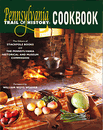Lumber Camps
This article originally appeared in Pennsylvania Trail of History Cookbook
One of the most interesting attractions at the Pennsylvania Lumber Museum in Galeton, Potter County, is the mess hall, which depicts one aspect of the life of lumberjacks in the heyday of Pennsylvania's nineteenth-century lumber camps.
When William Penn arrived in 1682, it is estimated that 90 percent of the state's 20,000,000 acres was covered with dense stands of white pine, eastern hemlock, and mixed hardwoods. When Pennsylvania's lumber industry peaked between 1850 and 1870, the state was the world's largest producer of lumber. Wood was needed for new homes and businesses, ships, firewood to heat homes, and charcoal for iron furnaces. To meet the demand for wood, loggers wielded handheld axes and two-man crosscut saws.
Lumberjacks had to be well fed, consuming an average of 8,000 calories a day to provide the energy needed to tackle the rigors of hard physical labor, especially during the cold winter months when much of the logging took place. One sound not heard during meals, often only five minutes long, was that of voices. Talking was forbidden at meals, as conversation among such a diverse group of men, living and working in close quarters, often led to fights.
Feeding a large crew of hungry loggers - as many as 75 to 100 in each camp - was quite a challenge for the lumber company cook and his assistants. Breakfast might include eggs, bacon, sausage, pancakes, and coffee or tea. Lunch pails were taken by sled or handcar to the lumberjacks so that they could remain close to the work area and finish quickly.
A hearty dinner generally featured meats, potatoes, Lumber Camp Skillet *, vegetables, breads, and desserts. Loggers coined nicknames for food, including cackleberries (eggs), stovelids (pancakes) *, doorknobs (biscuits), goldfish (canned salmon), gravel (salt), sand (sugar), redlead (ketchup), logging berries (prunes), Murphys (potatoes), slush or blackjack (coffee), and swamp water (tea).
* Recipes for these dishes are available in the Pennsylvania Trail of History Cookbook
Visit
Pennsylvania Lumber Museum, Galeton, PA
Walk into a re-created lumber camp and discover the life of 19th-century loggers.
For Further Reading
 |
Pennsylvania Trail of History Cookbook Edited by Kyle R. Weaver, Diane B. Reed, and Fred Lauver Forward by William Woys Weaver Stackpole Books and Pennsylvania Historical and Museum Commission 2004 |
 |
Pennsylvania Lumber Museum: Pennsylvania Trail of History Guide by Robert Currin Stackpole Books and Pennsylvania Historical and Museum Commission 2005 |




